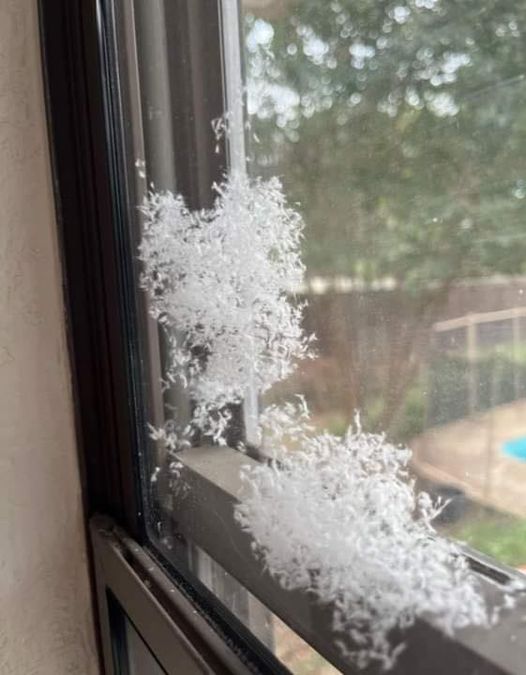If you wake up to find your windows fogged up with mysterious white fuzz, you might wonder if it’s harmless cotton or something more sinister. This fuzzy coating could indeed be mold—specifically, white mold, which grows quietly and can be difficult to detect. Knowing the risks of mold, especially on windows, can be crucial for maintaining a healthy home environment.
Understanding the Growth of White Mold
White mold often appears in areas with high humidity and moisture, thriving in colder months when warm indoor air meets cold window glass. While common in damp places like bathrooms, basements, and attics, it can easily find its way onto window sills, drawn by condensation and other moisture sources. Unlike the more noticeable black mold, white mold can blend into light surfaces, making it difficult to spot.
White mold can pose significant health risks, potentially causing respiratory problems, allergies, and other symptoms like nausea or headaches. Even though it may appear harmless, prolonged exposure could worsen symptoms, particularly for people with asthma or allergies. As with any mold type, prompt removal is essential.
Differentiating White Mold from Efflorescence
 White mold often resembles another common phenomenon called efflorescence. Efflorescence occurs when water vapor pulls salts out from materials like concrete or brick, leaving a white, powdery residue on the surface. Unlike mold, efflorescence is not a living organism, and it poses no health risks. To identify whether the white fuzz is mold or efflorescence, conduct a simple test: dampen a cloth and wipe the area. If the fuzz dissolves, it’s likely efflorescence; if it remains, it’s more likely to be mold.
White mold often resembles another common phenomenon called efflorescence. Efflorescence occurs when water vapor pulls salts out from materials like concrete or brick, leaving a white, powdery residue on the surface. Unlike mold, efflorescence is not a living organism, and it poses no health risks. To identify whether the white fuzz is mold or efflorescence, conduct a simple test: dampen a cloth and wipe the area. If the fuzz dissolves, it’s likely efflorescence; if it remains, it’s more likely to be mold.
The Risks of Mold and Efflorescence on Your Windows
While efflorescence can be unsightly and can damage masonry if left untreated, it doesn’t carry the same health implications as mold. However, both can contribute to unwanted issues if not managed properly. Mold, in particular, may indicate underlying structural problems, as it tends to thrive in hidden moisture pockets caused by leaks or insufficient insulation. Over time, mold can even compromise the structure of your home by eroding materials, so addressing it quickly is key.
How to Safely Remove Mold
To remove mold from windows, start by gathering protective equipment like rubber gloves, goggles, and a face mask. Safety should be your first priority, as mold spores can irritate the skin, eyes, and respiratory system. Open windows for ventilation and use a dehumidifier if possible to reduce moisture levels in the room.
Start by drying the area with a microfiber cloth. Then, spray undiluted white vinegar directly on the moldy spots and let it sit for about an hour. Afterward, scrub the area thoroughly. Once you’ve removed visible traces, let it dry completely to prevent mold regrowth.
If the mold remains, use a mixture of one cup of bleach to one cup of water, scrubbing with a nylon brush. For stubborn cases, try a stronger solution of 20 parts water, 10 parts bleach, and 1 part detergent. Remember never to mix vinegar and bleach, as this produces dangerous fumes. In cases where mold penetrates deeply into the wood, it may be necessary to sand and refinish the affected area.
When to Call a Professional
If you’ve followed these steps and the mold persists, or if the growth is widespread, consider contacting a professional mold removal service. Persistent mold could signal more extensive water damage, and a professional can perform a thorough inspection to ensure there are no hidden sources of moisture that could cause mold to return.
Prevention Tips to Avoid Mold Growth
Preventing mold requires managing indoor humidity levels and reducing moisture around windows. Here are some tips to help keep your windows mold-free:
- Use a Dehumidifier: Especially useful in humid areas, a dehumidifier reduces the overall moisture level in your home.
- Ventilation: Open windows periodically or use exhaust fans, particularly in bathrooms and kitchens where humidity levels rise quickly.
- Fix Leaks Immediately: Any sign of leaking water should be addressed promptly to prevent mold-friendly dampness from accumulating.
- Seal Windows Properly: Ensure window frames are well-sealed, which helps keep out moisture and reduces condensation.
- Clean Regularly: Regular cleaning can prevent dust and dirt from accumulating, as these contribute to mold growth when mixed with moisture.
Why Mold Growth on Windows is a Growing Concern
Homeowners may underestimate the seriousness of mold growth, viewing it as an occasional annoyance rather than a potential health hazard. But white mold, which often goes unnoticed, can cause issues over time, especially in homes with children, elderly residents, or people with pre-existing respiratory conditions. The CDC warns that mold exposure can exacerbate asthma, create allergy-like symptoms, and, in rare cases, lead to infections in vulnerable individuals.
Windows, as entry points for outdoor air, dirt, and other particles, are especially susceptible to mold and mildew, particularly when condensation forms regularly. While large mold infestations are more obvious, smaller spots of white mold may be missed or ignored until they spread, creating an even bigger problem.
In conclusion, treating and preventing window mold goes beyond simple cleaning. It requires understanding the underlying factors that allow it to thrive. By staying vigilant, conducting regular maintenance, and addressing any signs of mold or moisture promptly, you can maintain a safer, healthier indoor environment.
